
Dr. Towana Hunter, Ed.D | In Service to the VBSPCA for 9 Months
It was 15 years ago that Dr. Towana Hunter first got involved with the Virginia Beach SPCA. While working with Southeastern Cooperative Educational Programs, she brought students to volunteer at our shelter once a week. “It was such a great opportunity for them,” says Dr. Hunter. “I love what the program has grown into.” Fast forward to now, as Dr. Hunter is finishing her first year of service as a member of the VBSPCA Board of Directors. She began her career as a mental health technician before taking a role as a school counselor and department chair for the Virginia Beach City Public Schools. In 2020, she earned her doctorate in educational leadership and is transitioning into an instructional specialist this month.
Fast forward to now, as Dr. Hunter is finishing her first year of service as a member of the VBSPCA Board of Directors. She began her career as a mental health technician before taking a role as a school counselor and department chair for the Virginia Beach City Public Schools. In 2020, she earned her doctorate in educational leadership and is transitioning into an instructional specialist this month.
Dr. Hunter lends her education expertise to influence the VBSPCA’s humane education program, which instills values of kindness and respect in children. “I’m most passionate about creating responsible humans,” says Dr. Hunter. “As a community, we depend on each other to do what is right when it comes to pets and animals. That includes vaccines, spay/neuter services, and overall commitment to providing the best care for your pet.”
Much like her initial involvement with the VBSPCA, Dr. Hunter encourages others to volunteer. “Another way to get involved would be fostering an animal, or sponsoring a fundraiser.” she adds.
Board members like Dr. Hunter are crucial to furthering the VBSPCA mission of eliminating animal suffering. We are thankful for everything she does to help our animals!
If you are interested in serving on the Virginia Beach SPCA Board of Directors, please email derby.brackett@vbspca.com for more information.
VBSPCA Pups to Play in Puppy Bowl
Two Virginia Beach SPCA pups will be playing in this year’s Puppy Bowl! Heidi and Sammie were both selected for Team Fluff, who will take on Team Ruff in the cutest matchup you’ll ever see.
While the big game is a few weeks away, it’s never too early to start planning for such an adorable event. Here’s how you can watch the Puppy Bowl and cheer on Heidi and Sammie:
At the Smartmouth Pilot House
Our friends at Smartmouth Brewing will be showing the Puppy Bowl at the Smartmouth Pilot House and have even created a special beer for the occasion! It takes place at 2pm on Sunday, February 13, 2022. While you’re enjoying the big game, be sure to try a VBSPCA Second Chance Sour Ale, a limited small batch production of Zoinks by Smartmouth Brewing Company. A portion of beer sales will be donated to the VBSPCA.
Watch at Home
This year’s Puppy Bowl will be shown on February 13th at 2pm on Animal Planet and can be streamed on Discovery+. Even if you decide to watch at home, you can still make a toast to Sammie and Heidi with our special edition beer! Stop by Smartmouth Brewing to pick up a four-pack of VBSPCA Second Chance Sour Ale beginning Friday, February 11th.
This year marks the fifth time that VBSPCA animals have made appearances in the Puppy Bowl. Jill, a kitten, was featured in the 2021 event. Now it’s Sammie and Heidi’s moment to shine! We’re so proud of our VBSPCA pups. Go Team Fluff!
Click here to learn more about this year’s Puppy Bowl.
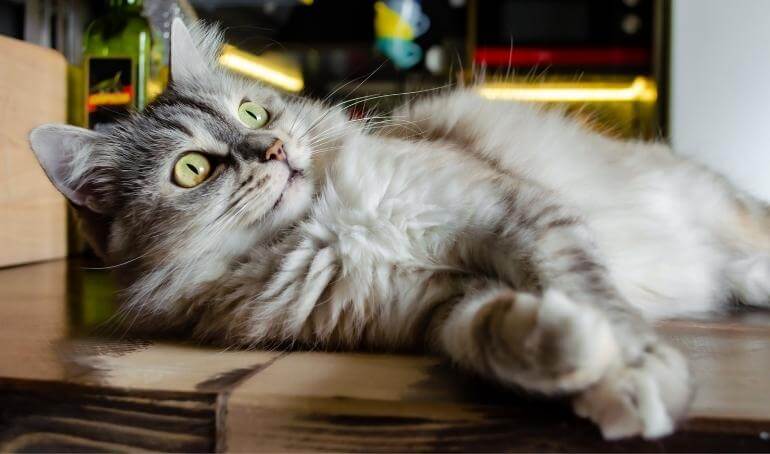
Grooming 101 | Tips for Caring for Your Pets
All dogs and cats need regular grooming to stay happy and healthy. Proper grooming includes keeping your pet’s eyes, ears, skin, nails, teeth, and fur clean. While all pets benefit from regular grooming, pets with long hair need a little extra attention to prevent their fur from getting tangled or matted.
Brushing your pet’s hair regularly does more than keep their hair tangle-free. It also removes dirt, spreads natural oils through their coat, and helps keep their skin clean. Brushing your pet’s hair is also the perfect time to make sure there are no fleas or ticks on your pet. Even dogs and cats who shed should be brushed 1-2 times per week.
Short-Haired Dogs
Dogs who have short hair and shed should be brushed once a week. Regular brushing can even help prevent the frustration of finding loose hair all over your home. Some dogs shed year-round while others shed seasonally in the spring and fall. If your canine companion is in a heavy shedding period, you should brush them more frequently than once a week.
In addition to brushing, your dog should be bathed at least once every three months. Consider bathing more frequently if your dog spends a lot of time outside or has skin issues.
Long-Haired Dogs
Dogs with long hair will need to be brushed daily to remove tangles and prevent matting. If you come across a tangle, gently brush it out. For tougher tangles and matts, carefully clip the hair instead, but be sure not to cut the skin.
Dogs with long, silky coats will also need to visit a professional groomer to have their hair trimmed approximately every 4-6 weeks. These breeds include Yorkshire Terriers, Shih Tzus, Poodles, and Maltese. In addition to a haircut, your pet’s groomer will also bathe them and trim their nails. It should be noted that dogs who have long hair and a double coat should never be shaved down including breeds such as Huskies, Golden Retrievers, and Pomeranians.
Short-Haired Cats
If your cat has short hair, you should comb their hair 1-2 times per week. Removing dead or loose hair through brushing will help prevent your cat from having hairball issues. Cats are mainly self-bathers: they use their tongue and teeth to bathe themselves. However, if your feline friend is overly dirty or gets into something sticky or smelly, you may need to give them a bath.
Long-Haired Cats
Cats with long hair will need to be brushed every few days to keep their long locks tangle-free. If you come across a knot, you can put a little talcum powder on the knot and use your fingers to tease it out. Just like short-haired cats, our long-haired friends are great about bathing themselves. However, if your cat is matted you may need to visit a professional groomer.
Professional Grooming Services
As mentioned above, keeping your pet properly groomed includes not only brushing their fur, but also trimming their nails, bathing them, and keeping their eyes, ears, and teeth clean. You may choose to purchase all of the necessary equipment and learn how to do these things on your own, but you should also enlist the help of a professional groomer when needed.
When to Groom at Home:
– You have the proper tools and supplies
– You feel comfortable using cutting shears, nail clippers, etc.
– Your pet is calm and cooperative
When to Contact a Professional:
– You don’t feel confident grooming your pet
– You do not or cannot invest in quality grooming equipment
– Your pet is uncooperative
Grooming your pet can be a difficult process at first, but with time and patience, it can become a great bonding experience.
Need help finding a professional groomer? Check out our list of recommended groomers here.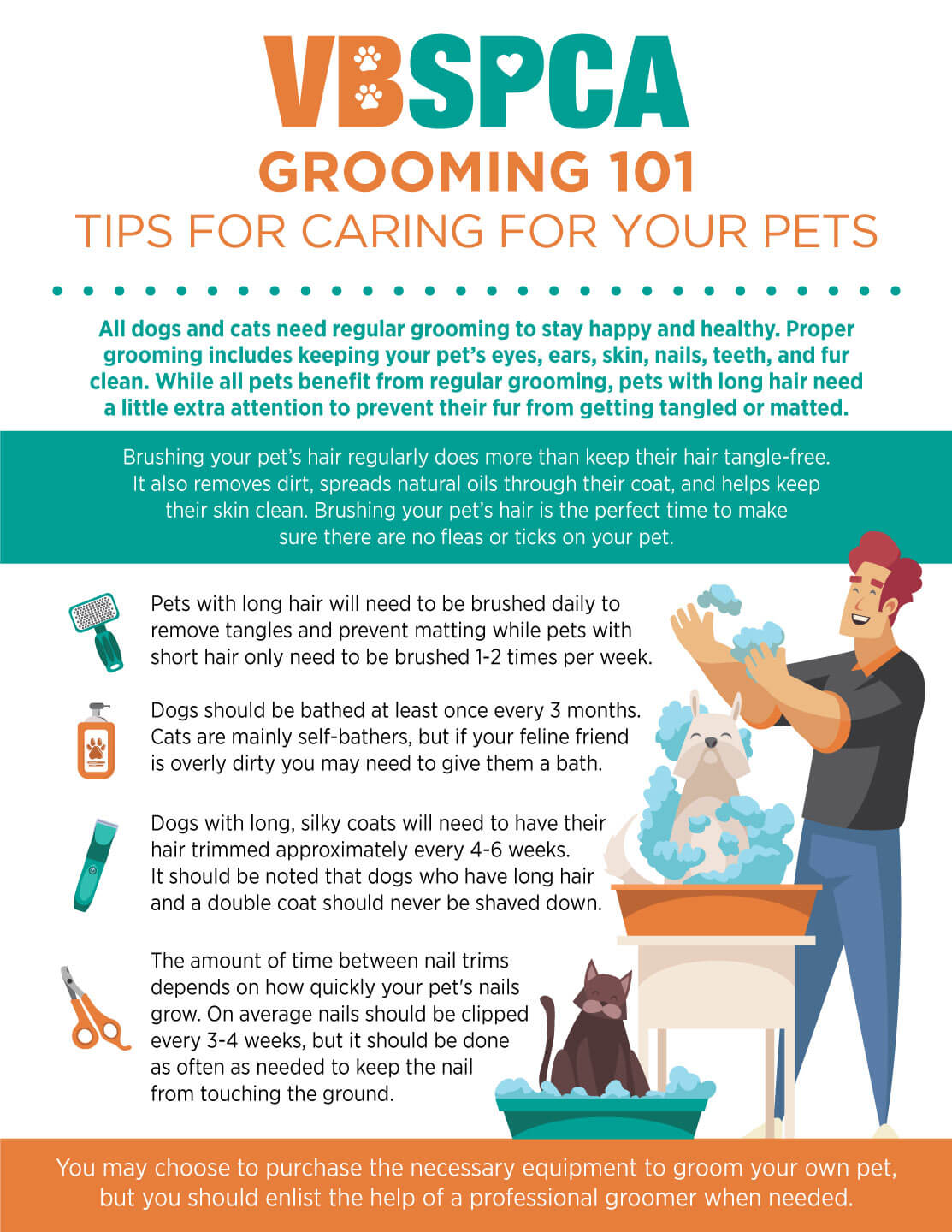

Happy Tails | Kenzo
Every single animal that comes through our shelter has a story. Some are complex, many are sad, but all of them get better the minute they arrive at the Virginia Beach SPCA. Kenzo was part of an unplanned litter of five puppies that was surrendered to the VBSPCA in February 2021. The long coat Chihuahua mixes went into a foster home until they were ready for adoption. When Amaya came in to meet the pups in March, Kenzo stood out from the rest of his siblings since he was the only boy and had golden hair. We recently caught up with Amaya to get an update on Kenzo.
How is Kenzo doing in the home?
Kenzo took no time at all to adjust when I initially adopted him. Now we’re practically in sync, and I can easily navigate his emotions and needs/wants. He’s happy, healthy, and has no problem letting me know when he isn’t.
 What sort of activities do you and Kenzo do together?
What sort of activities do you and Kenzo do together?
Kenzo and I love to cuddle! Any time I’m taking a nap, he’s right by my side. We also frequent trips to grandma’s house so he can get all of those no-no snacks he can’t get at home and he pays her in kisses (Grandmas! Am I right?). Other than being PetSmart junkies, we spend most of our time playing tug-of-war or fetch, or simply lounging around.
Does Kenzo have any funny quirks?
Kenzo likes to do this weird thing where anytime we’re playing fetch and I have the toy in my hand ready to throw it, he’ll jump up to grab it with no regard for landing. He doesn’t seem to account for what will happen once it’s time to come out of the air and simply throws his body. He completely disregards the need for a landing pose, clear ground, and just looks like a fish out of water. I’m assuming it’s pure dedication, and he’s just willing to compromise his body to achieve the goal of getting the toy from my hand. I aspire to be as dedicated to my goals! (Minus the sacrificing of my limbs…)
How has Kenzo enriched your lives so far?
I find myself constantly expressing my appreciation for being Kenzo’s mom. He is supportive, kind, and understands me so well. Before adopting him, I never truly understood the depths of relationships with pets. I now know it is one of the most rewarding experiences anyone could have. We have such a long road ahead of us, but this small amount of time we’ve already spent together is enough to fill my heart for a lifetime.
Why do you think people should consider adopting a shelter pet?
I’m a first-time adopter, and like many others I had concerns with adopting. The first would be not being able to find a breed that would suit my lifestyle. The second was finding a dog that would have trouble adjusting since I’m not equipped with enough knowledge. Both of my concerns were easily dismissed when I found Kenzo. I’d tell anyone who is interested in adopting that it’s a journey that requires patience, but the perfect pet is out there! You just have to find each other.
Is there anything else you would like to add?
Adopting was extremely cost efficient and educational. When I adopted Kenzo, I was given all of his necessary medications, some food, and plenty of helpful resources to answer any questions I had. The VBSPCA also had an affordable clinic, which was a huge win! I was able to afford adoption, shots, meds, and new pet supplies, which still totaled to half of what it’d cost me to purchase a dog elsewhere. I was taught signs to look for when integrating him with other dogs and new people. The VBSPCA also gave me helpful advice on feeding, potty training, and crate training! I look forward to adopting again in the future.

Happy Tails | Cali
Every single animal that comes through our shelter has a story. Some are complex, many are sad, but all of them get better the minute they arrive at the Virginia Beach SPCA. Cali arrived at the VBSPCA in August of 2019 as a young puppy. She wasn’t in our care for very long. Delynda had been wanting to adopt a puppy, and the moment she laid eyes on Cali, she knew the little Golden Retriever mix was “the one”. We recently caught up with Delynda to get an update on Cali.
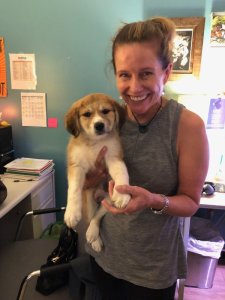 How’s Cali doing in the home?
How’s Cali doing in the home?
Cali instantly took to our home and her big brother Lewie (a Llewelyn Setter). Even though she is smaller than Lewie, she rules the roost. She is perfectly happy when we crate her but we are now, as she is a little more than two years old, able to leave her out during the day with Lewie when we are gone for short periods. Cali is extremely smart and does well with training. She is extremely food motivated.
We have met some challenges that have given us the opportunity to love on Cali and pour more affection into her. She tends to be very fearful and somewhat anxious when meeting new people. It feels great to continue building her confidence as we watch her become more trusting of us and the new situations we experience.
What sort of activities do you and Cali do together?
Cali loves to go for walks and can’t get enough of the car. Almost every evening my husband and I take the dogs out on our dock to watch the sunset on North Landing River at Munden Point. We have a gate on the end of the dock so we can unleash the dogs and let them explore safely. They enjoy watching the birds, the jumping fish, and the boats going by.
Does Cali have any funny quirks?
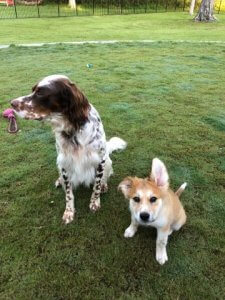 There’s one I call the “Cali Flip.” If she trusts a person and they pet her, she instantly melts and flips on her back without even trying. She absolutely adores belly rubs! She also knows when it is getting close to feeding time; she silently and suddenly appears, all the while attempting to look adorable, which she has no problem doing as she always makes her adorable Cali face.
There’s one I call the “Cali Flip.” If she trusts a person and they pet her, she instantly melts and flips on her back without even trying. She absolutely adores belly rubs! She also knows when it is getting close to feeding time; she silently and suddenly appears, all the while attempting to look adorable, which she has no problem doing as she always makes her adorable Cali face.
How has Cali enriched your life so far?
Cali is such a bright light in our lives. It makes me so proud that she trusted me enough to bring her into our home. She keeps us giggling every day. She is pure joy!
Why do you think people should consider adopting a pet from a shelter?
People should realize that pets do not end up in a shelter on their own will. It is important to acknowledge that a pet’s past life and home situation may certainly have a bearing on their demeanor. Animals deserve a second chance at a solid family life. Animals who are given care and affection will often flourish in the right loving environment.
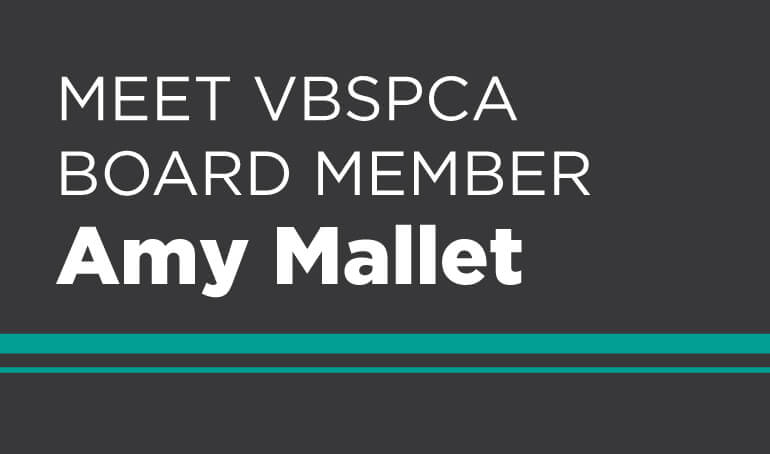
Amy Mallet | In Service to the VBSPCA for 2 Years
As a proud pet parent of two rescue dogs, Amy Mallet is a passionate advocate for animal adoption. She joined the Virginia Beach SPCA Board of Directors two years ago because of her experience with her own pets. “By serving on the VBSPCA Board of Directors, I have been able to share that joy of pet adoption with others and garner more support for animals looking for forever homes,” said Mallet.
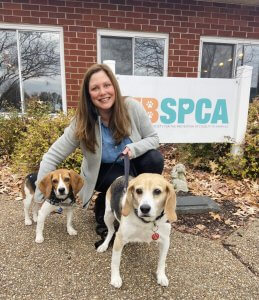 With more than 20 years of experience in marketing and communications, Mallet lends her expertise to the VBSPCA and other organizations. She is currently the manager of the Virginia Natural Gas Corporate Communications team and serves as the chair of the Virginia Natural Gas EverGreen team, a group dedicated to supporting the company’s environment and sustainability efforts. Mallet also volunteers her time to the Bay Beagle Rescue, Salvation Army, and United Way. She lives in Virginia Beach with her two Beagles, Cooper and Wilson.
With more than 20 years of experience in marketing and communications, Mallet lends her expertise to the VBSPCA and other organizations. She is currently the manager of the Virginia Natural Gas Corporate Communications team and serves as the chair of the Virginia Natural Gas EverGreen team, a group dedicated to supporting the company’s environment and sustainability efforts. Mallet also volunteers her time to the Bay Beagle Rescue, Salvation Army, and United Way. She lives in Virginia Beach with her two Beagles, Cooper and Wilson.
Mallet says she was drawn to volunteer with the VBSPCA because of its mission to provide compassion for animals in need. “I am a passionate champion for the welfare of our animals,” said Mallet. “The VBSPCA exemplifies its dedication to being true community partners by teaching individuals to be more humane and responsible in the treatment of animals.”
Educating the community about the variety of services offered at the VBSPCA is a priority for Mallet. She hopes to inspire others to support the animals in any way they can. “The VBSPCA provides opportunities for people of all ages to touch the lives of animals who need a warm home and lots of love,” said Mallet. “Individuals can volunteer to take a dog for a walk, read to animals, donate supplies, foster a pet, participate in a fundraising event, or give monetary donations, just to name a few.”
Dedicated individuals like Mallet ensure the VBSPCA can continue working towards its mission of eliminating animal suffering. We are grateful for everything she does to help our animals!
If you are interested in serving on the Virginia Beach SPCA Board of Directors, please email Emily.Peck@vbspca.com for more information.

Happy Tails | Gouda
Every single animal that comes through our shelter has a story. Some are complex, many are sad, but all of them get better the minute they arrive at the Virginia Beach SPCA. Gouda arrived at the VBSPCA in May of 2021. His previous owners surrendered him because another cat in the home did not appreciate his playful nature. The two year old orange tabby kept getting looked over at our shelter until a special little girl named Ella visited him. After two months in our care, Gouda had finally found his home and was adopted in July. We recently caught up with Ella to get an update on Gouda.
How did you know Gouda was the one for you?
My mother called me and said she was looking at cats while at work and we should get one. My dad was not thrilled with this idea at all. See, my dad is a dog person and has never liked cats. I immediately went to get my phone to look at the VBSPCA’s website and saw this beautiful tabby boy named Gouda. I knew he was the cat for us because my mom owns a charcuterie business. I also read that he did not like other cats, which was great because we have two dogs and I knew he would like them. The next morning, my mom and dad took me to the VBSPCA to go look at Gouda. I immediately fell in love with him and so did my mom. I even sweetened the pot by saying that I would pay for all his adoption and set-up fees, but I asked my mom and dad if they would help me with the food because I don’t have a job and he needs to eat.
How is Gouda doing in the home?
Gouda has two new brothers, Smokey and Bandit, the Mini Australian Shepherds. They have become good friends and play all the time. Gouda thinks he is an Aussie, even greeting us at the door with his brothers. He has another brother too which he is not sure about. Red Beard is a Bearded Dragon who constantly stares at him wondering what he is doing in his room and where this furball came from.
What sort of activities do you and Gouda do together?
Gouda has a hammock that sits in the window, so he is comfortable watching TV with the family and his crazy brothers. He likes to play with my dad every night and will not go to sleep until my dad and mom kiss me goodnight and my brothers jump all over my bed. He also likes to be put under the covers with me to sleep at night. He loves to have his belly rubbed just like his brothers; he even tries to take their bones from them and gets jealous when he does not have one of his own. Whenever he wants pets, he shakes his tail and bounces all over the house until you pay attention to him.
How has Gouda enriched your lives so far?
My Dad, even though he did not want a cat, thinks that Gouda is a great addition to the family. My Mom is smitten with him and even gets a little upset that Gouda will not sleep with her, but he does make sure that she works out every morning, even critiquing her form on the Peloton.
Why do you think people should consider adopting a shelter pet?
We would have never found him if it were not for the great people at the VBSPCA and the time and effort that they put into every animal. I think that people need to adopt more shelter pets because they are amazing and need good homes, even though Gouda has become more dog-like than cat-like.
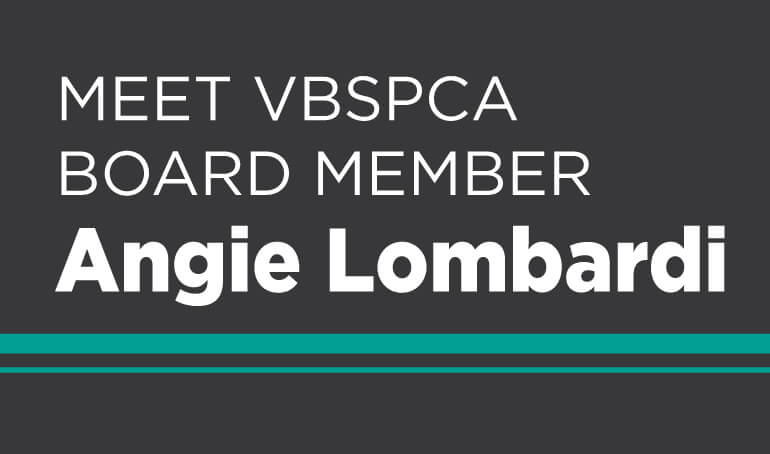
Angie Lombardi | In Service to the VBSPCA for 9 Years
As a lifelong animal lover, Angie Lombardi began volunteering at the Virginia Beach SPCA over a decade ago. Once she learned more about the organization, she jumped at the chance to serve on the Board of Directors. “I wanted to help make a difference in the lives of the pets and be their voice,” said Lombardi. Nine years later, she remains an engaged member of the board. “The VBSPCA can’t take care of these sweet souls without support from the community it serves.”
Lombardi provides the VBSPCA with expertise in marketing. She has 20 years of experience in marketing and sales including her current role as Vice President of Marketing at The Franklin Johnston Group. In addition to her service to the VBSPCA, Lombardi volunteers her time on the board of the Virginia Apartment Management Association. 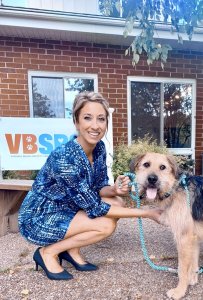 While she connects very closely with the VBSPCA’s overall mission, Lombardi is most passionate about the level of compassion provided to both the animals and their families. “Seeing how the team works with family members who need to relinquish their pets, partnering with other animal welfare organizations and rural shelters that need more support – the love and care that is put into the animals that end up at the shelter is remarkable.”
While she connects very closely with the VBSPCA’s overall mission, Lombardi is most passionate about the level of compassion provided to both the animals and their families. “Seeing how the team works with family members who need to relinquish their pets, partnering with other animal welfare organizations and rural shelters that need more support – the love and care that is put into the animals that end up at the shelter is remarkable.”
Lombardi focuses on getting the word out about the many ways the community can support the VBSPCA. “Adopt, foster, donate (money or supplies), attend events, sign up to be a volunteer, share our stories on social media… It’s truly amazing how much goes on within the shelter and clinic and how many animals are cared for every single day.”
Dedicated individuals like Lombardi ensure the VBSPCA can continue working towards its mission of eliminating animal suffering. We are grateful for everything she does to help our animals!
If you are interested in serving on the Virginia Beach SPCA Board of Directors, please email Emily.Peck@vbspca.com for more information.
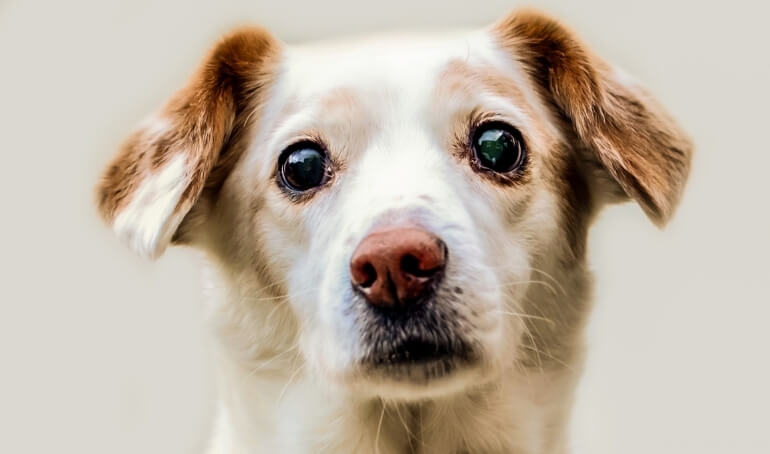
Allergies in Pets | Causes & Treatment Options
Anyone who has ever dealt with allergies certainly understands the misery those symptoms can bring. Unfortunately cats and dogs can also suffer from allergies.
There are three main causes of allergies in pets: fleas, environmental allergies, and food allergies. The most common symptoms of allergies include itchy skin, coughing or sneezing, discharge from the nose and/or eyes, and vomiting and/or diarrhea. As always, see your veterinarian if you notice your pet has those symptoms.
Flea Allergies
Flea bites usually only cause minor irritation in dogs or cats. However, those who are allergic to flea bites can have a severe reaction to just a single bite. Animals who are allergic to flea bites will chew or scratch incessantly, usually losing large amounts of hair in the process. The resulting irritation on the skin can also lead to a bacterial infection. Your veterinarian can prescribe a steroid or antihistamine, and if necessary, an antibiotic.
The best way to prevent issues resulting from flea bites is to apply monthly flea treatments to your cat or dog. Even if your pet is not allergic, these preventatives will help them avoid the discomfort that comes from flea bites.
Environmental Allergies
Just like humans, dogs and cats can react to a variety of environmental allergens such as tree pollens, grasses, molds, and dust mites. While people with these allergies mainly suffer from upper respiratory symptoms, pets are most likely to have severely itchy skin causing them to lick, chew, and even rub up against things to try to alleviate the itching.
Bathing your pet can reduce their discomfort and wash off the offending allergen(s). Your veterinarian can also prescribe medication that can be administered at home or provide your furry friend with an injection to combat their symptoms.
Food Allergies
Food allergies are much less common than flea or environmental allergies, but they can occur. If your pet does have a food allergy, chances are they are allergic to the protein used in the food, not the grains. Symptoms of a food allergy include gastrointestinal issues and itchy skin.
If your veterinarian suspects your pet has a food allergy, the only way to know for sure is a food elimination trial. Your veterinarian would prescribe a very specific diet and you would not be able to feed your pet anything else during the trial. If your pet’s symptoms improve, your veterinarian would then have your pet return to his original diet to confirm the allergy. If a food allergy is confirmed, your veterinarian can help develop a feeding plan for your cat or dog.
Other Allergens
Pets can also have allergic reactions to insect bites, medications, vaccinations, and other substances. In addition to the symptoms mentioned above, other signs that your dog or cat is having an allergic reaction include swelling or redness, lethargy, and difficulty breathing. Whether your pet is experiencing a dangerous reaction or his usual seasonal allergies, it is important to seek help from your veterinarian to keep your pet happy and healthy.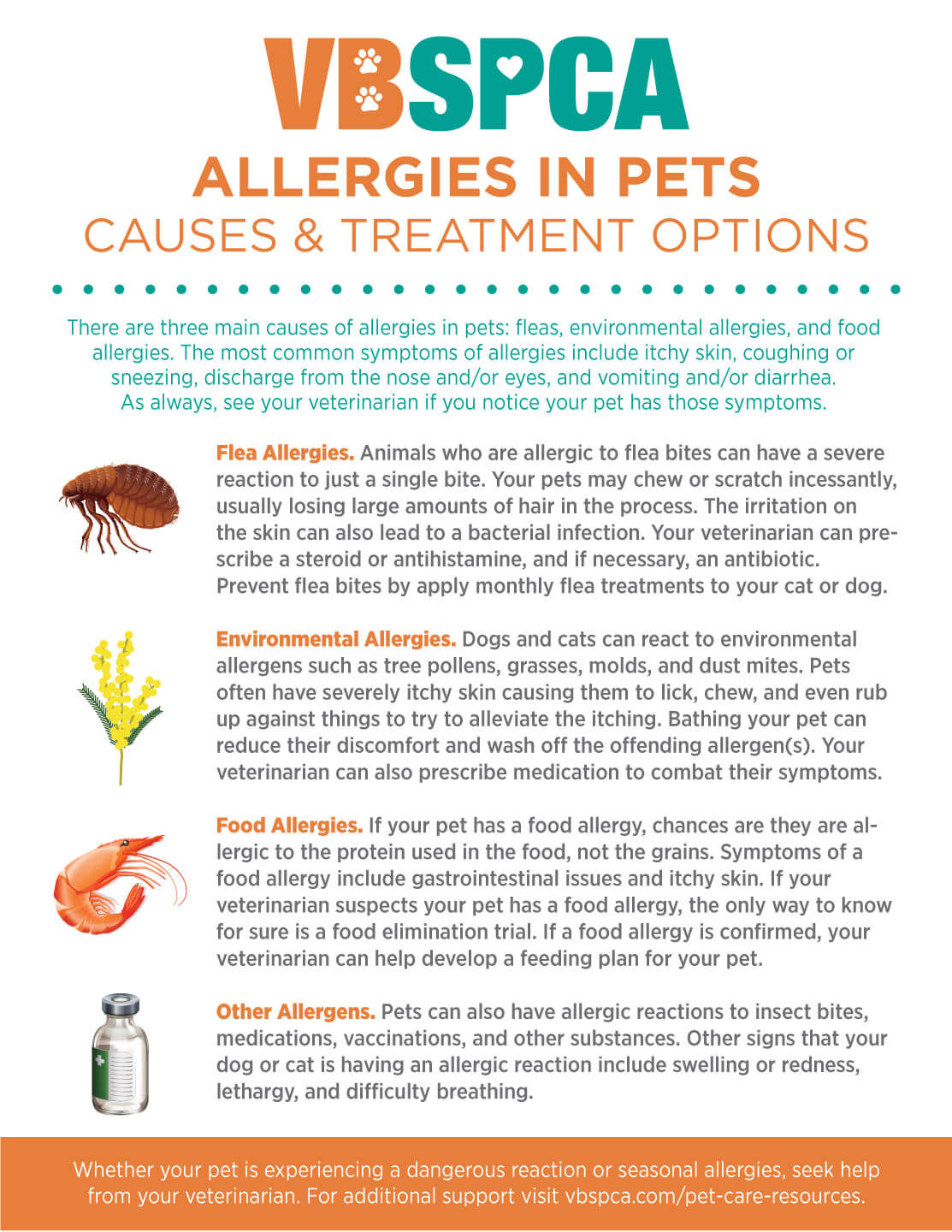

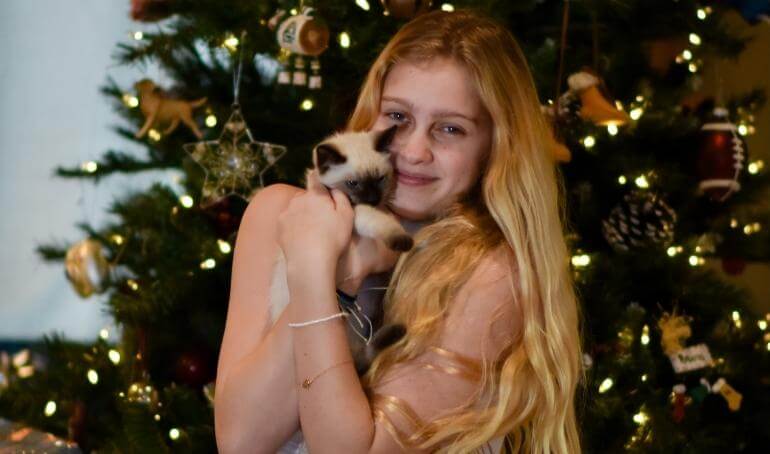



















Posted: February 1, 2022 by vbspcaadmin
Happy Tails | Emmie
Every single animal that comes through our shelter has a story. Some are complex, many are sad, but all of them get better the minute they arrive at the Virginia Beach SPCA. Emmie and her two sisters were found abandoned as young kittens in November 2021. The trio was placed into a VBSPCA foster home until they were strong enough for the adoption process. Once Emmie was back at the shelter, it didn’t take long for her to catch the eye of Sharalee and her family. We recently caught up with Sharalee to get an update on Emmie.
We adopted Emmie on Saturday, December 4th, 2021. Our daughter Lily, 13, had been asking for a kitten for years. We waited until we knew she would be able to care for her in the way a cat needed. The tears in our daughter’s eyes when we pulled into the VBSPCA Shelter’s parking lot is a moment we will always remember.
How did you know Emmie was the one for you?
We knew right away we wanted to meet Emmie. Her Siamese coloring was just too beautiful to ignore. There was another couple in the room with her, and we had no way of knowing if they would select her. We played with several other kittens and fell in love with all of them. However, once we started playing with Emmie and my daughter held her, we knew she was the one.
How is Emmie doing in the home?
Emmie is doing wonderfully. She is snuggly and talkative, meowing the second she sees someone. She stretches out her paws from her cat tree and begs to be picked up. She always wants a snuggle.
What sort of activities do you and Emmie do together?
We play with her with toys or on her cat tree. She likes looking in mirrors. We also got her a harness to take her on walks, though she’s not quite used to that yet. The first couple of times we put on the harness, she just flopped right over. We are taking it slowly introducing her outside. She is excited to see everything but gets overwhelmed.
Does Emmie have any funny quirks?
Emmie does this little trilling noise when she runs and plays. It’s not a purr or meow. It’s like a rolling squeak. She will hide under the bed and then leap at your arm and roll over onto her back clutching your arm before she darts off again to prowl after her next victim.
I’ll be honest and say that we weren’t expecting the whole family to fall in love with Emmie. She was my daughter’s and still primarily stays with her. However, it has brought our family together as we fight over who gets to play with her or snuggle with her next. She is certainly loved!
Why do you think people should consider adopting a shelter pet?
There are so many animals that need love and a home. We never considered a breeder. My husband and I visited the shelter prior to bringing our daughter in and there were so many precious animal babies needing homes. We knew immediately that our daughter would have no problem finding her forever little best friend.
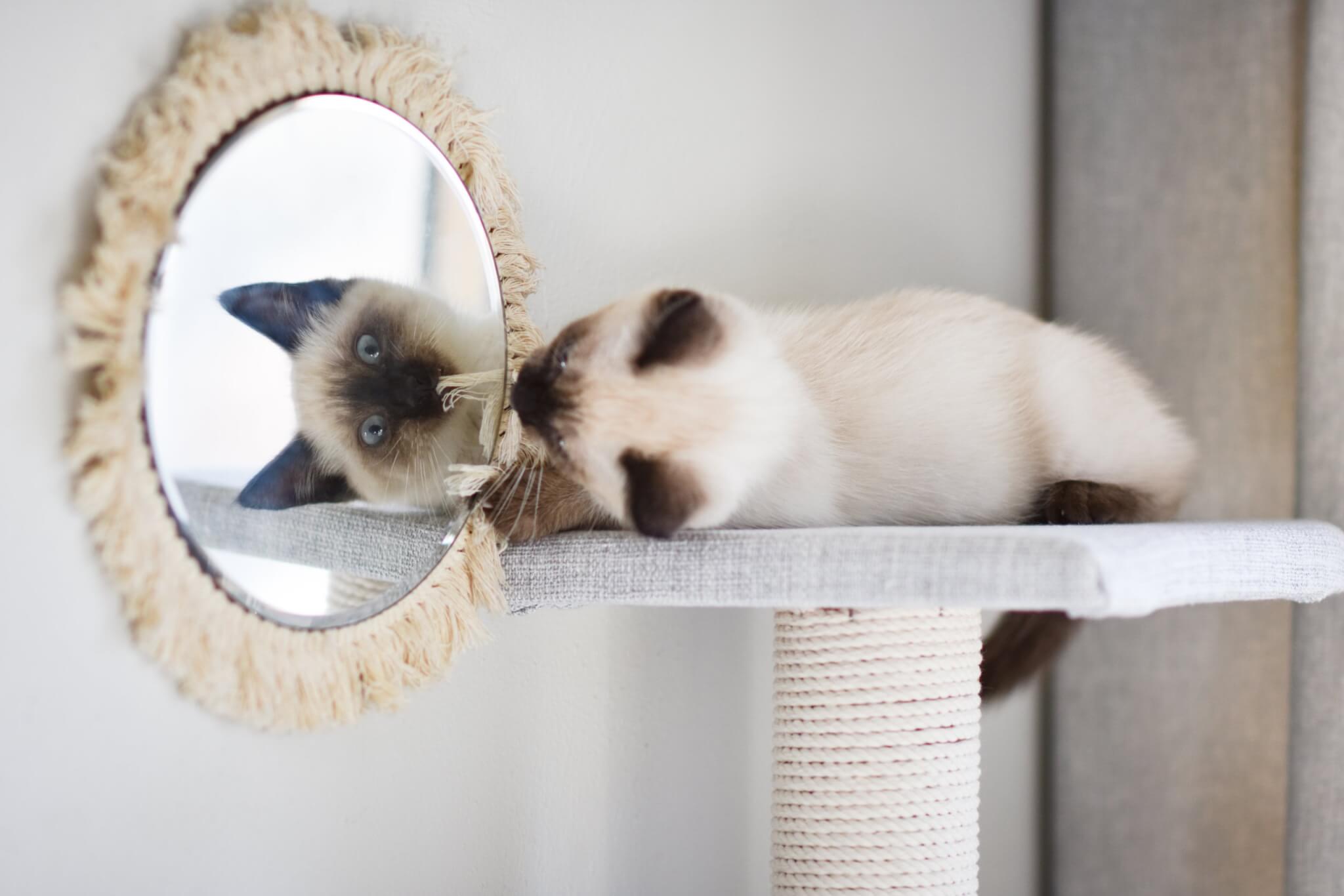
I am so grateful for the VBSPCA caring for not just our sweet Emmie before we welcomed her home, but all the animals that have entered their doors, whether they had a short or long stay.